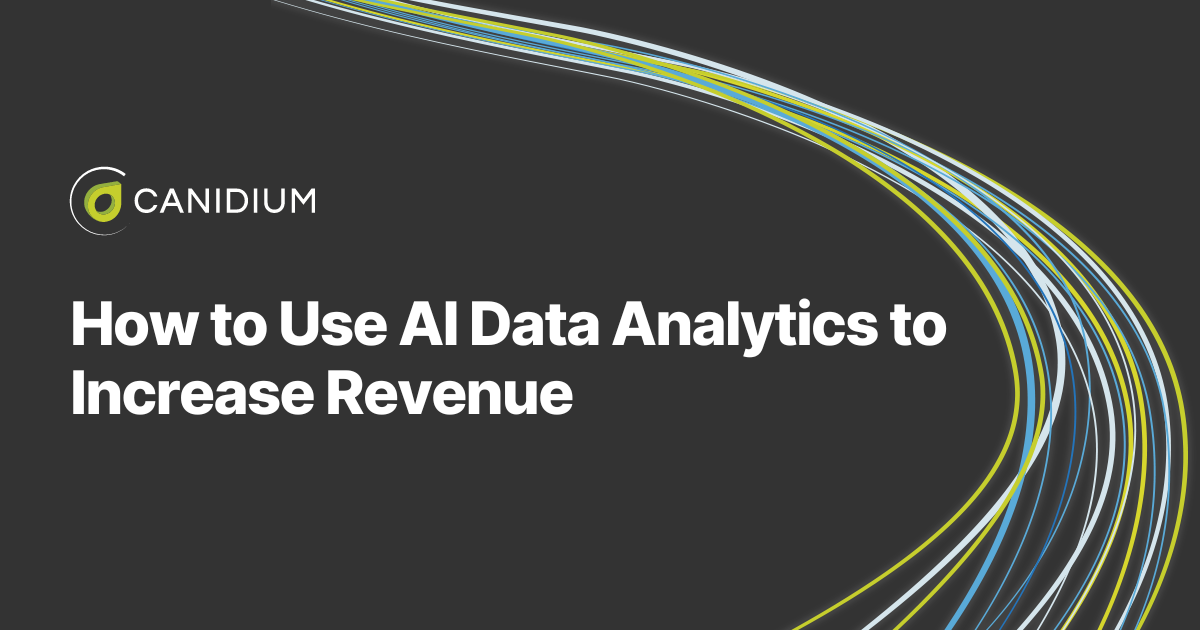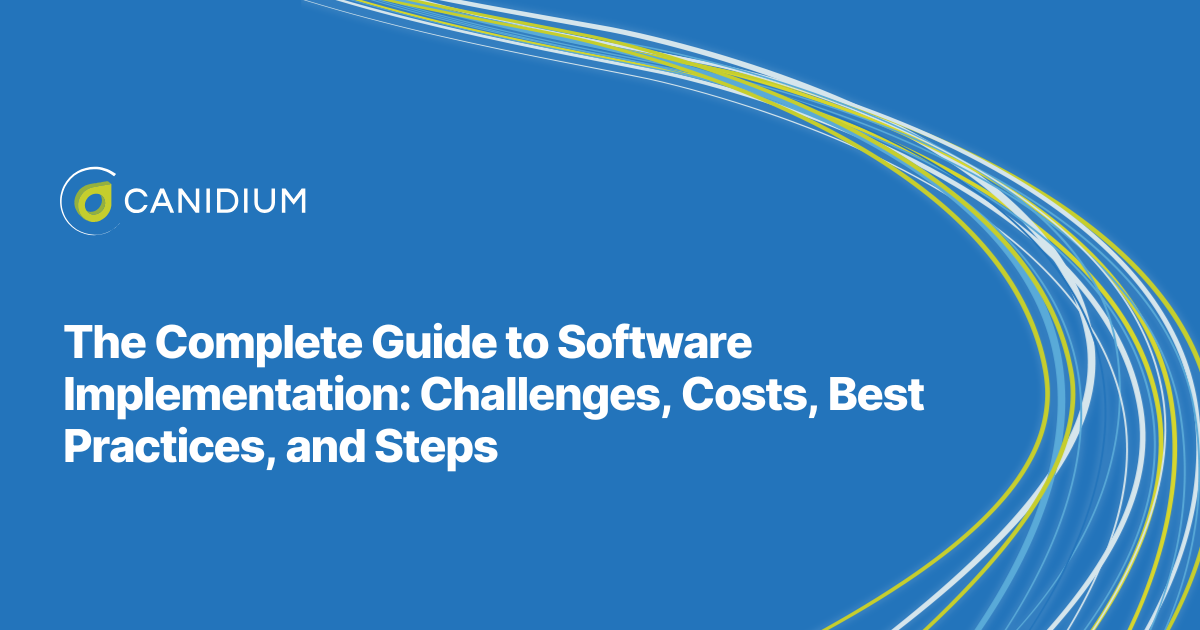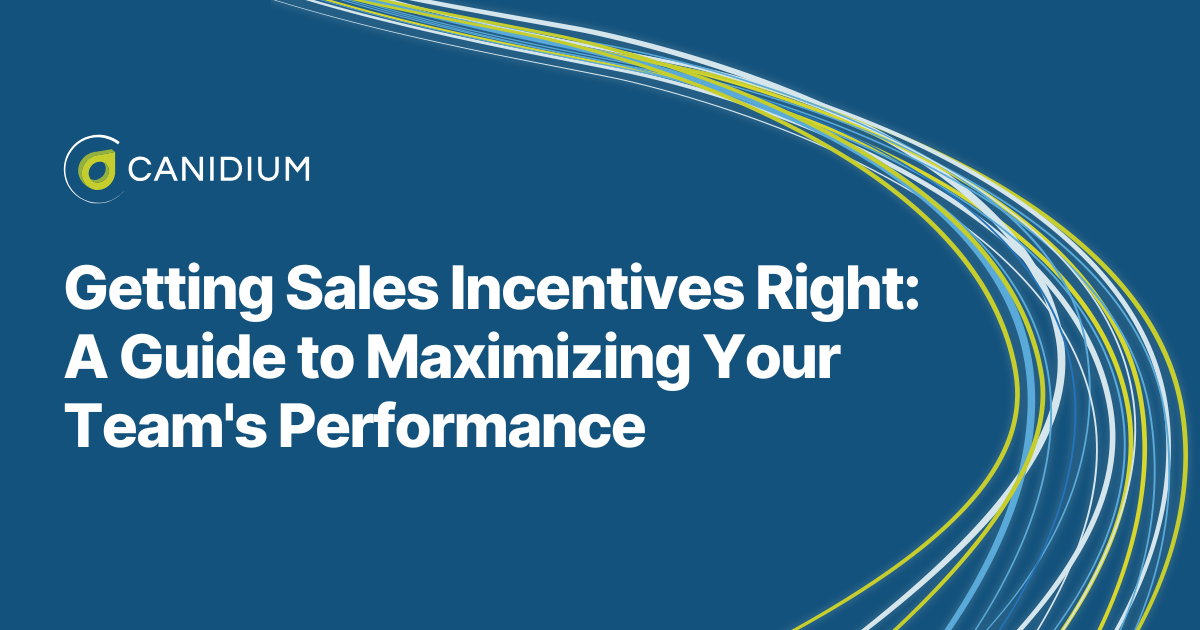It is not an overstatement that artificial intelligence (AI) has taken the business world by storm. The versatility of new machine learning and AI tools allows innovators to leverage them in novel technologies and established tools alike. Companies are incorporating AI into most digital processes. However, the ubiquity of AI begs the question: how can businesses implement AI technologies to achieve the most significant effect?
At Canidium, our team of implementation experts helps organizations plan for and integrate new technologies. We deal with the latest technological innovations across different industries and applications, giving us detailed insight into best practices.
Based on our experts' detailed knowledge of AI, this article offers a comprehensive guide to its use in data analytics. We will cover the following topics:
- What is AI data analytics?
- How businesses are leveraging AI and machine learning for analytics
- Is AI a replacement for data analysts?
- How to use AI analytics tools to generate actionable insights that drive revenue
What Is AI Data Analytics?
AI can mean many different things. The highly intelligent and advanced digital tools powered by artificial intelligence and machine learning serve a wide variety of functions, with analytics being one of the subcategories of AI most broadly useful to businesses.
AI data analytics refers explicitly to using artificial intelligence technologies, particularly machine learning algorithms, to analyze and interpret complex data sets. AI-enabled analytics tools offer more efficient processing and deeper insights into large volumes of data. These solutions can automate the extraction of meaningful patterns, predict outcomes, and make decisions with minimal human intervention.
There are several different categories of AI data analytics:

- Predictive Analytics: Using historical data to predict future outcomes, such as customer behavior or market trends.
- Prescriptive Analytics: Offering recommendations based on data analysis to help businesses take informed actions.
- Machine Learning: Automatically improving and adapting analyses based on new data without manually programming each change.
- Deep Learning: Using advanced neural networks to analyze data with complex structures, like images or sound.
The ability to handle vast and diverse data sets quickly and accurately makes AI data analytics invaluable for businesses seeking to leverage their information for competitive advantage.
How Businesses Are Leveraging Artificial Intelligence and Machine Learning Models For Analytics
Embedded AI analytics tools, like those offered by SAP, are revolutionizing business operations by providing meaningful insights directly within transactional workflows. These tools enhance decision-making across various sectors and enable businesses to monitor KPIs and react swiftly without switching systems.
The specific uses of the tools vary by industry and company. Still, the core functionality can be broadly outlined by sector. In retail, analytics personalize customer experiences by using behavior and purchase data. For manufacturing and logistics, predictive analytics help forecast maintenance needs and optimize routes, reducing costs and downtime. Financial sectors benefit from real-time reporting and compliance monitoring, which aid risk management and regulation adherence. These tools also improve supply chain visibility, allowing businesses to manage inventory effectively and anticipate disruptions.
In human resources, embedded analytics analyze workforce data to inform performance, retention, and talent development decisions. Additionally, they support sustainability initiatives by tracking environmental impacts and helping companies align operations with ecological goals.
Is AI a Replacement for Data Analysts?
A recent survey found that 77% of respondents were worried that AI would displace workers in the near future. Alternatively, the World Economic Forum estimates AI will create 97 million new jobs. These statistics seem contrary, but a more nuanced trend emerges if you dig deeper. AI, like many technological advancements that came before, is not eliminating the workforce but changing employees' work.
There is an overwhelming concern among workers regarding the use of artificial intelligence. AI's capabilities—automating repetitive tasks, uncovering hidden patterns, deep learning-based decision-making, managing vast amounts of data efficiently, and completing complex tasks in a matter of seconds—are beyond the capabilities of human hands. Yet, while AI tools enhance data processing and reporting capabilities, they are not expected to make data analysts redundant. Instead, these tools are likely to reshape the role.
AI data analysis solutions cannot perform complex problem-solving or strategic planning at the human level. These tools may still make basic errors that require oversight. Therefore, data analysts should view these tools as enhancements to their capabilities rather than threats.
AI excels at handling large data sets and can automate routine tasks such as data analysis and report generation. This automation can free you up to focus on more complex and strategic aspects of your role that require human insight, such as interpreting data in context and making nuanced decisions.
The fear that data analysts will become redundant is unlikely to be actualized. One survey found two-thirds of managed service provider (MSP) respondents indicated that implementing AI within their company would lead to either no change in their staffing numbers or an increase. Moreover, the Bureau of Labor Statistics estimates that Operations Research Analyst roles will grow 23% between 2022-2023. At the same time, Market Analysts' roles will grow by 13%.
However, the introduction of AI tools will still significantly change the role. Data analysts must learn how to effectively leverage AI to remain a valuable force for employers. Analysts can stay relevant by adapting to these technological changes and leveraging AI to handle routine tasks.
How to Use AI Data Analytics Tools to Generate Actionable Insights That Drive Revenue
Globally, the AI market is projected to grow at a CAGR of 36.6% from 2024 to 2030. This adoption rate suggests that AI tools will become standard for businesses in the next few years, and companies that do not harness these tools risk falling behind. Yet, despite the urgency with which AI is being integrated into business processes, it still pays to slow down and strategize before investing.
Because AI is an all-encompassing term for various tools designed to serve different functions, companies must take a strategic approach to selecting and integrating AI tools. Companies that report strategically scaling AI saw almost triple the return on their investments compared to companies implementing isolated proof of concepts. This suggests that a holistic, integrated approach to adopting AI across various business processes and departments is significantly more beneficial financially than implementing AI in standalone, disconnected projects.
The best approach to implementing an AI solution is to plan how its capabilities can maximize the effect within existing internal structures and business intelligence processes.
The best way to start strategizing in AI analytics is to define how your tools will integrate into your business so you know which solutions serve your purpose.
Define Your Business Goals
Harvard Business School outlines four considerations businesses should consider when setting goals. These considerations can be summarized as such:
.png?width=1920&height=1080&name=The%20Four%20Categories%20of%20AI%20data%20analytics%20(1).png)
- Financial Performance: Align goals with profit plans and budgets to assess economic value and meet investor expectations.
- Customer Satisfaction: Focus on understanding and enhancing customer experiences to support long-term success.
- Internal Business Processes: Optimize internal operations across management, innovation, and regulatory compliance to support overall business health.
- Learning and Growth: Invest in developing human capital, information systems, and organizational culture to foster a workplace conducive to innovation and growth.
These goal-setting parameters can be factored in without the use of AI data analytics, but decisions will not be based on comprehensive insights, and thus, the results are unlikely to be ideal. Injecting the use of AI analytics tools into these considerations allows decision-makers to base their goals on material realities, both internal and external.
Let's reexamine how to leverage AI for each consideration:
- Financial Performance: Analytics can monitor revenue growth, cost management, and profitability KPIs. It enables businesses to track financial health in real time, predict future trends, and adjust strategies accordingly. For instance, predictive models can help forecast revenue based on current market trends and internal performance metrics.
- Customer Satisfaction: Businesses can identify patterns and trends in customer behavior and preferences by analyzing customer data and feedback. Analytics tools can track customer satisfaction scores, churn rates, and engagement levels across various touchpoints. This data helps businesses understand what drives customer loyalty and how to enhance the customer experience to meet or exceed expectations.
- Internal Business Processes: Analytics can be applied to streamline operations and increase efficiency. By examining data from internal processes, companies can identify bottlenecks, inefficiencies, or areas for improvement. Process mining and other analytical techniques can provide insights into workflow effectiveness, helping to refine processes and improve operational efficiency.
- Learning and Growth: Analytics aids in measuring the effectiveness of training programs and professional development initiatives. By evaluating the impact of learning and growth activities on employee performance, businesses can better understand the ROI of their development programs. Analytics can also help track skills advancement within the workforce, guiding future investments in training and development to align with strategic goals.
The insights buried in business data provide targeted improvements that decision-makers can take action on or potential opportunities that may have otherwise gone overlooked. This allows companies to set relevant and achievable goals that have a measurable impact on their growth, costs, revenue, or any number of other factors.
Prepare Your Data and Implement an Embedded AI Analytics Solution
The quality of your business analytics and decision-making is a direct reflection of the quality of your data. Inaccuracies, redundancies, or missing information within your data pipeline can generate misleading reports, undercutting the potential benefits of insight-driven decision-making.
AI's ability to handle vast amounts of data helps your analytics team go through the totality of your organizational information with a fine-tooth comb, increasing the granularity of your reports. However, if your data pipeline isn't properly set up to funnel accurate, clean data to your tool, even the most robust solution can not effectively deliver optimal results.
Designing, configuring, and implementing your solution is as important a process as selecting your AI analytics tool. At the same time, preparing data for implementation as a data analytics tool is crucial for ensuring the success of your analytics initiatives. Working with a software implementation partner is one of the most effective ways to ensure that your data analytics will deliver maximal value.
Here's what the implementation process will look like when you are working with an experienced partner:
.png?width=1920&height=1080&name=The%20Four%20Categories%20of%20AI%20data%20analytics%20(2).png)
- Objective Definition: Working closely with your team, SI partners define and refine business goals for analytics to ensure strategic alignment.
- Data Collection: They help internal teams manage the efficient extraction and collection of valuable data from diverse sources.
- Data Cleaning: Using advanced tools, SI partners can work with your internal implementation team to automate the removal of errors and duplicates to ensure high data quality.
- Data Integration: SI partners handle the integration of data from multiple systems into a consistent and unified view.
- Data Transformation: They adjust and optimize data to meet specific analytics tool requirements, enhancing readiness for the analysis process.
- Data Reduction: SI partners implement techniques to simplify data and optimize analytics tool performance.
- Data Governance: Robust frameworks are established and maintained, ensuring data is managed securely and appropriately.
- Documentation: Comprehensive documentation of processes, ensuring compliance with industry standards, is provided by SI partners.
- UAT: The analytics tool's user acceptance testing (UAT), including troubleshooting and optimization, is managed to assess its functionality and effectiveness.
- Feedback and Iteration: SI partners analyze feedback from testing to refine processes and make necessary adjustments for continuous improvement.
Your SI partner can also help you choose the right analytics tool based on your unique business needs, budget, and goals. Once your solution is live, you can develop data-driven analytics and reporting processes.
Create Workflows That Leverage Valuable Insights to Foster Data-Driven Decision Making
Data maturity is a vital component of leveraging AI-generated insights. When a company exhibits low data maturity, it typically suggests that both staff and management overlook the significance of their data. In contrast, high data maturity is marked by a business proactively collecting and employing data to enhance its operations. To foster data maturity, a company must develop strategies and cultivate behaviors that optimize the utilization of its data resources. Only 37% of technical decision-makers feel their companies' data maturity is best in class.
To improve your organization's data maturity, you must develop a workflow incorporating data insights into your decision-making processes. Your software implementation partner will help establish the technical infrastructure you need to facilitate data-driven analytics. They will assess and refine the data collection and processing workflows to ensure the quality and timeliness of the data fed into the analytics tool. This might include automating more data inputs and establishing stringent data quality checks. At the same time, your partner will work with your internal team to refine these models based on initial feedback and performance. They will also create customized dashboards that present data insights in an actionable manner and conduct targeted training sessions to ensure that all relevant staff are proficient in using the new tool and understanding its outputs.
With these tools in place, the next step is actively incorporating data insights into strategic planning sessions. Use the tool's predictive capabilities to inform future strategies and potential adjustments to current plans. This helps align operational tactics with long-term business objectives.
The goal is to reinforce a culture that values and understands the importance of informed decisions. This may involve recognizing and rewarding departments or individuals who effectively use data to drive improvements or innovations.
Monitor the Impact of Your Decisions With Analysis Tools
You may want to set up a data review committee or working group. This committee should meet regularly to review the data insights generated by the AI solution, discuss how these insights are being used across the organization, and evaluate their impact on specific decision-making processes. The data review committee should advocate for ongoing training and development opportunities related to AI and data analytics. Promoting understanding and engagement with AI tools across the organization will help sustain a data-driven culture.
Create a framework for evaluating the ROI of your artificial intelligence solution. Track metrics such as efficiency, cost savings, revenue growth, customer satisfaction, or other relevant KPIs based on your business objectives. By setting these benchmarks, you can directly measure how AI contributes to tangible business outcomes.
Finally, use the insights gained from monitoring and evaluating your AI solution to establish best practices within the organization. The data review committee can play a crucial role in disseminating these practices and success stories throughout the organization, helping to standardize effective data use and AI applications across all departments.
You can also incorporate a feedback loop in which your managed service provider uses insights from the data review and ROI evaluation to refine the AI solution. This could involve tuning the AI algorithms, expanding data inputs, or adjusting integration points based on what works well or areas that need improvement.
Leveraging AI Data Analytics to Increase Revenue
Utilizing AI technologies like machine learning, businesses can analyze complex datasets more efficiently, automate pattern recognition, predict outcomes, and facilitate decision-making with minimal human intervention. Critical applications include predictive analytics for forecasting customer behavior and deep learning for processing complex data forms like images.
Industries from retail to manufacturing are integrating AI analytics into their operations to leverage data-driven insights that improve efficiency and decision-making. For example, in retail, AI personalizes customer interactions by analyzing behavior data, while in manufacturing, it optimizes logistics to reduce costs.
The integration of AI is not about replacing jobs but enhancing roles, enabling professionals to focus on more strategic tasks. Businesses are advised to adopt AI holistically across processes to maximize ROI. Effective implementation involves setting clear goals, leveraging AI insights to meet these goals, and collaborating with partners to ensure high data quality.
Establishing a data-driven culture with workflows that leverage AI insights and continuous monitoring of AI's impact is crucial. This helps businesses harness AI effectively to drive growth and maintain competitive advantages.
If you are interested in implementing a new analytics solution, start by learning how to pick a software implementation partner.








